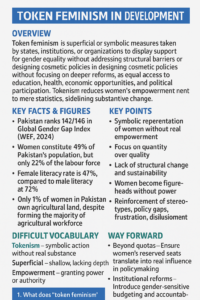Token Feminism in Development: A Cosmetic Commitment?
Overview
The term token feminism refers to superficial or symbolic measures taken by states, institutions, or organizations to portray support for gender equality without addressing the structural barriers that women face. In development discourse, this often translates into appointing a few women in leadership, introducing gender-focused slogans, or designing cosmetic policies, while ignoring deeper reforms such as equal access to education, health, economic opportunities, and political participation. Tokenism risks reducing women’s empowerment to mere statistics, sidelining substantive change.
Key Outlines
1. Understanding Token Feminism
- Definition: Symbolic representation of women without real empowerment.
- Nature of Tokenism: Focus on quantity over quality (numbers instead of influence).
- Difference from Genuine Feminism: Lacks structural change and sustainability.
2. Token Feminism in Development Policies
- Representation in Institutions: Women appointed to boards or ministries without decision-making authority.
- Donor-Driven Agendas: Gender quotas fulfilled to satisfy international agencies.
- Project-Based Inclusion: Temporary gender-focused projects that vanish after funding ends.
3. Global and Local Dimensions
- Global: UN and World Bank often criticized for rhetorical gender mainstreaming.
- Pakistan: Gender quotas in parliament (20%) but weak role in policymaking.
- Workplace: Women hired to “tick boxes” while excluded from leadership decisions.
4. Consequences of Token Feminism
- Superficial Change: Women become figureheads without power.
- Reinforcement of Stereotypes: Perception that women are incapable of leadership.
- Policy Gaps: Development programs fail to address real issues such as wage gaps, violence, and health inequities.
- Frustration and Disillusionment: Weakens the feminist movement’s credibility.
5. Facts and Figures
- Pakistan ranks 142/146 in Global Gender Gap Index (WEF, 2024).
- Women constitute 49% of Pakistan’s population but only 22% of the labor force.
- Female literacy rate: 47%, compared to male literacy at 72%.
- Political representation: Reserved seats for women 20%, but actual decision-making roles are minimal.
- Only 1% of women in Pakistan own agricultural land, despite forming the majority of the agricultural workforce.

Difficult Vocabulary with Synonyms/Antonyms
- Tokenism – symbolic action without real substance
- Synonyms: superficiality, pretension, facade
- Antonyms: authenticity, sincerity, substance
- Superficial – shallow, lacking depth
- Synonyms: cosmetic, hollow, surface-level
- Antonyms: profound, genuine, meaningful
- Empowerment – granting power or authority
- Synonyms: enablement, strengthening, liberation
- Antonyms: disempowerment, subjugation, oppression
- Structural Barriers – systemic obstacles
- Synonyms: institutional hurdles, systemic constraints
- Antonyms: opportunities, facilitators, enablers
- Marginalization – exclusion from mainstream opportunities
- Synonyms: sidelining, alienation, neglect
- Antonyms: inclusion, acceptance, recognition
CSS-Relevant Analytical Questions
- Critically evaluate the concept of token feminism in development discourse with reference to Pakistan.
- How do reserved quotas for women in politics strengthen or weaken gender empowerment?
- Examine the difference between token representation and substantive participation of women.
- Assess the impact of tokenism on Pakistan’s progress towards SDG-5 (Gender Equality).
- Suggest a framework to replace token feminism with meaningful gender mainstreaming.
MCQs (for CSS/PMS Practice)
- What does “token feminism” primarily imply?
a) Genuine gender equality
b) Symbolic representation without structural change
c) Equal opportunities in education
d) Feminist movements in history- Answer: b
- Which Sustainable Development Goal (SDG) is directly linked to gender equality?
a) SDG-3
b) SDG-5
c) SDG-8
d) SDG-10- Answer: b
- Pakistan’s ranking in the Global Gender Gap Index 2024 is:
a) 110/146
b) 132/146
c) 142/146
d) 146/146- Answer: c
- What percentage of women hold reserved seats in Pakistan’s parliament?
a) 10%
b) 15%
c) 20%
d) 25%- Answer: c
- Which of the following best describes “marginalization”?
a) Integration into society
b) Exclusion from opportunities and decision-making
c) Equal participation in governance
d) Socioeconomic empowerment- Answer: b
Way Forward
- Beyond Quotas: Ensure women’s reserved seats translate into real influence in policymaking.
- Capacity Building: Invest in women’s education, leadership training, and entrepreneurship.
- Institutional Reforms: Introduce gender-sensitive budgeting and accountability frameworks.
- Cultural Transformation: Challenge stereotypes and promote gender equality through media, curriculum, and legislation.
- Grassroots Mobilization: Empower rural women in agriculture, health, and community development projects.
Conclusion
Token feminism remains one of the most pressing “lingering issues” in global and local development frameworks. While it creates the illusion of inclusivity, it fails to dismantle systemic barriers that perpetuate inequality. For Pakistan, moving beyond cosmetic measures towards genuine empowerment is essential not only for achieving SDG-5 but also for sustainable national progress. Real change requires political will, institutional reforms, and social transformation to make women equal partners in development rather than symbolic participants.

